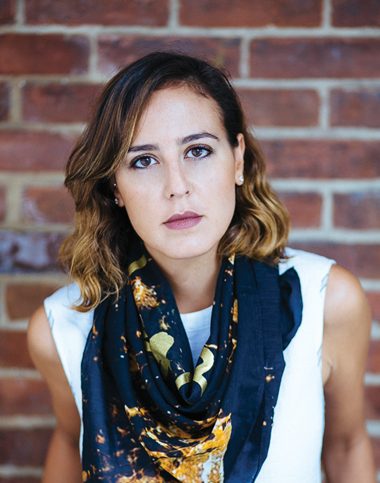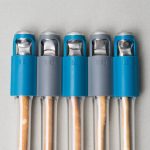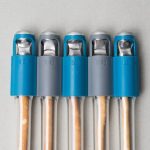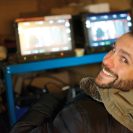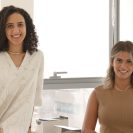What is a designer? Merely a person who creates visions into objects or concepts for other people to enjoy? Or more formally, (and according to Webster’s Dictionary) one who creates and often executes plans for a project or structure, and in practice, anyone who creates tangible or intangible objects, such as consumer products, processes, laws, games and graphics, is referred to as a designer. Leen Sadder, a talented Lebanese designer with a resume filled with credits boasting in both the Middle East and the United States, defines herself with an effective simplicity that mirrors her crisp, low-key work: “I’m a designer and a problem solver.”
Leen, who we are excited to hear speak at the upcoming Nuqat Conference, dishes that her design work ranges from branding, typography and hand-lettering to user experience, mobile and web design. Her most recent project, THIS Toothbrush, her personal startup consisting of a range of products that revive the miswak, (an ancient tool used of oral hygiene), will be a focal point in her role as a speaker at this year’s conference, as it ties in with the theme- The Copy/Paste Syndrome, and also ties in with her self proclaimed reputation as a problem-solving designer. “Even though my range is broad from a format perspective, I think the thread that ties it all together is my passion for creating solutions through design.”
We at bazaar tracked down the current Dubai-based designer to gather her two cents on the idea of design, the theme of this year’s conference, and a sneak peek regarding the input she’ll share about her experiences as a designer. We’re also digging into her new startup and her inspiration behind its importance.
What are some of your current projects you’re working on?
I’m mostly dedicated to launching my startup, THIS Toothbrush- but I’ve also been giving design workshops, consulting, and continuing my freelance branding work. I’m also involved with AIGA Middle East, which I helped launch a few years ago.
What are some of your notable past projects you’ve worked on?
Most recently, I worked on the re-design of a website for one of the largest multinationals in the U.S. I’ve also developed branding for Manousheh, a Lebanese bakery and cafe in New York City, created an online platform for girls in Lebanon, designed a mobile e-commerce analytics app, and worked with various brands such as Dove and TedX. THIS Toothbrush is by far the most interesting and bizarre one so far.
How do you feel about the theme of this year’s Nuqat conference?
The Copy Paste Syndrome resonates with me quite a bit, especially having lived both in the Middle East and in the U.S. It’s a topic that spans across different industries but is most easily identifiable in design due to its visual nature. I think it’s crucial to create discourse around what it means to innovate versus imitate- especially in a world that is becoming more global and more uniform by the minute.
How do you feel your project THIS Toothbrush has benefited/will benefit the Eastern and Western markets?
The mission behind THIS Toothbrush is to celebrate a forgotten piece of culture by making it relevant to today’s markets, both Eastern and Western. THIS shares an age-old secret of ours with the rest of the world, and introduces it as a natural alternative to the common toothbrush. On the other hand, it also gives the miswak a chance of revival in parts of the world that are familiar with its religious and cultural significance, but have perhaps deemed it unworthy of preserving.
Can you tell us a bit more about why you’ve reintroduced the classic miswak?
The miswak not only has a rich story to tell in terms of culture and history, it also is highly beneficial to dental health as a natural alternative to modern methods of oral hygiene. When I first started learning about its medicinal benefits and origins, I was surprised to find that such a fascinating piece of knowledge had gotten lost through the generations. THIS was born out of a desire to bring the miswak to the 21st century and reintroduce it to the modern world.
Since the theme for this year’s conference highlights the Copy Paste Syndrome, would you consider your work as a positive copy of a past creation?
It’s definitely something I’ve thought about quite a bit while working on THIS. Since the miswak is a natural product, I wouldn’t consider my work to be a copy of a creation, but rather an elevation of something that came before us. What we’re trying to do is to preserve a dying piece of heritage by telling its story in a language today’s world responds to. Whether it’s positive or not I’m yet to find out, but so far the response has been pretty great!
What will you be focusing on as a speaker at the Nuqat conference?
I’ll be looking at the Copy Paste syndrome from a cultural perspective by exploring the concepts of preservation, imitation and innovation. I’ll also be looking at what role we as designers play in facilitating these concepts.
Any words of encouragement to aspiring designers out there?
Design is a superpower- the more you challenge and train it, the stronger it gets. Learn how to use it and you’ll be surprised to find out just how much you can do with it.
Interested in design? Take the opportunity to hear Leen Sadder speak at this year’s Nuqat Conference taking place between November 12-18. For more information on Nuqat or to register, visit www.nuqat.me. For more information on Leen Sadder, visit her website at www.leensadder.com.



